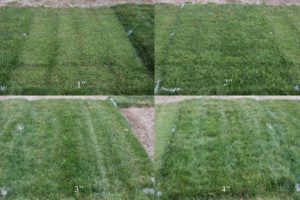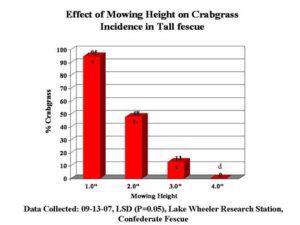Mowing Height Impacts Weed Populations
go.ncsu.edu/readext?474955
en Español / em Português
El inglés es el idioma de control de esta página. En la medida en que haya algún conflicto entre la traducción al inglés y la traducción, el inglés prevalece.
Al hacer clic en el enlace de traducción se activa un servicio de traducción gratuito para convertir la página al español. Al igual que con cualquier traducción por Internet, la conversión no es sensible al contexto y puede que no traduzca el texto en su significado original. NC State Extension no garantiza la exactitud del texto traducido. Por favor, tenga en cuenta que algunas aplicaciones y/o servicios pueden no funcionar como se espera cuando se traducen.
Português
Inglês é o idioma de controle desta página. Na medida que haja algum conflito entre o texto original em Inglês e a tradução, o Inglês prevalece.
Ao clicar no link de tradução, um serviço gratuito de tradução será ativado para converter a página para o Português. Como em qualquer tradução pela internet, a conversão não é sensivel ao contexto e pode não ocorrer a tradução para o significado orginal. O serviço de Extensão da Carolina do Norte (NC State Extension) não garante a exatidão do texto traduzido. Por favor, observe que algumas funções ou serviços podem não funcionar como esperado após a tradução.
English
English is the controlling language of this page. To the extent there is any conflict between the English text and the translation, English controls.
Clicking on the translation link activates a free translation service to convert the page to Spanish. As with any Internet translation, the conversion is not context-sensitive and may not translate the text to its original meaning. NC State Extension does not guarantee the accuracy of the translated text. Please note that some applications and/or services may not function as expected when translated.
Collapse ▲As we prepare for warmer temperatures (hopefully), it is important to remember the advantages of maintaining a healthy, actively growing turf to help combat weeds. Smooth and large crabgrass (Digitaria spp.) are common annual grassy weeds in managed turf in North Carolina.
One of the simplest and most economical ways to ensure turfgrass species such as tall fescue remain healthy and actively growing throughout the growing season is to mow at the proper height and frequency. Many homeowners mow their lawn shorter than recommended. The close mowing may cause scalping and induce stress making it less able to compete with crabgrass and other weed species.
Field experiments were initiated at Lake Wheeler Turfgrass Field Lab in Raleigh, North Carolina to determine the effect of tall fescue mowing height on crabgrass incidence. Evaluated mowing heights included 1″, 2″, 3″, or 4″ and were initiated once soil temperatures reached an optimum for crabgrass emergence and trials were evaluated monthly for crabgrass incidence through September. By mid-September, 1″, 2″, 3″, or 4″ tall fescue mowing heights resulted in 95%, 48%, 13%, and 0% crabgrass cover, respectively. These data indicate maintaining tall fescue at the appropriate mowing height may culturally suppress crabgrass in tall fescue.






